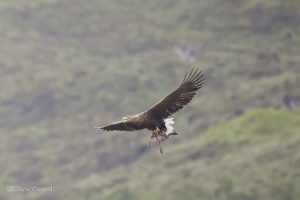By Peter Guthrie & Peter Dale
Rewilding seems to be the in thing at the moment, so how about returning the Mountain Hare to the Peninsular, for a number of reasons which I will explain later
This first passage taken from Saving Britian’s Wildlife reads as follows:
Mountain hares are indigenous to Britain, unlike the other lagomorphs, the rabbit and the Brown hare, which were introduced by man. (We have to blame the Romans for that) Although elsewhere in its broad circumpolar distribution, the mountain hare mainly occupies Boreal Forest. In Britain it is associated with heather moorlands, particularly those which are managed by burning in strips for red grouse. It is native to the Highlands of Scotland but has been introduced to the Southern Uplands, the Peak District and on some Scottish Islands including Hoy (Orkney), Mainland (Shetland), Mull (If Mull wishes to surreptitiously introduce Pine Martens for the benefit of the tourist, and quite possibly from Morvern/Ardnamurchan why not return the favour) and Skye.

Mountain Hare were found on the peninsula until the mid 1960s when the last ones were shot, so we are not talking about a species that didn’t eek out a living over the years here.
The indiscriminate shooting of Mountain Hare in the Cairngorms to protect the Red Grouse shooting grounds is something that troubles us greatly as passionate wildlife folk (Peter Dale: Or Managers, as in my book if it means pulling the trigger at times, so be it.)
We have a huge Golden Eagle population across the peninsula, which according to the experts is failing in its production of young due to the lack of natural food sources (the same experts also take young from the area for release in other parts of the country) but few rabbits and hare as a key food source for the birds. Why not relocate the mountain hare to the peninsula rather than cull?
One of the main food sources for Golden Eagles are rabbits and brown hares and these are important species in the food chain and this element is critical for good production of chicks and fledged birds. As the only native species, we would be keen to see Mountain Hare and obviously less keen on the introduced species. In order to maintain and improve the population, increasing the key prey species allows the population to thrive naturally rather than rely on supplementary feeding.
In other areas, such as the Cairngorms, Golden Eagle’s primary food will be Mountain Hare, but they are naturally adaptable and have to be on the peninsula as one of the most important secondary sources is game birds, such as Red and Black Grouse (Don’t forget Ptarmigan) and we don’t have many of those either.
Golden Eagle is just one species that needs these animals. Another that needs this element in the food chain is the Scottish Wildcat and while these may be extremely rare, even on the peninsula, to help their recovery at some point they will need this food source.
Once reasonable numbers have been achieved, this provides a steady food source year-round, rather than the boom-and-bust approach with gralloch and winter losses
How do we go about doing it?
So, we’ve covered the why it would make sense, but how do you go about doing it? Methods must be humane and care should be taken when finding ranges.
There are many ways of trapping Hare, but as an example, the use of an old method such as long netting may cause limited stress to the animal, but there isn’t really any method that is perfect for such an activity and surely, it’s better than shooting them? Relocating animals will allow us to build a viable population across the peninsula to benefit all of our predator
Please share any and all opinions with us. We want to hear from you get in touch



